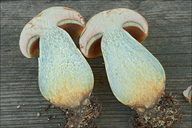|
|
click photo for larger file

Suillellus luridus
Lurid Bolete
|
Photographer: Dr. Amadej Trnkoczy
ID: 0000 0000 1018 0050 (2018-10-01)Copyright © 2018 Dr. Amadej Trnkoczy
|
|
INFORMATION PROVIDED WITH THE PHOTO
|
date of photo Sep 24, 2018
latitude 46.35923 longitude 13.70548
View on Google Maps.
location
Lower Trenta valley, between villages Soča and Trenta, right bank of river Soča; next to the trail from the main road Bovec-Vršič to farmhouse Skokar, Trenta 2, East Julian Alps (Posočje, Slovenia)notes Slo.: noroglavka, svinjski goban - Boletus luridus Schaeff. : Fr., Leccinum luridum (Schaeff.) Gray, Tubiporus luridus var. rubriceps Maire - Habitat: Steep mountain slope, east aspect; mixed wood, Fagus sylvatica, Ostrya carpinifolia and Picea abies dominant trees; under Fagus or eventually Ostrya; in shade; calcareous, skeletal ground; partly protected from direct rain by tree canopies; average precipitations ~ 3.000 mm/year, average temperature 7-9 deg C, elevation 535 m (1.750 feet), alpine phytogeographical region. - Substratum: soil. - Comments: Suillellus luridus, formerly named Boletus luridus, is with little doubts the commonest bolete in Trenta valley. The species is very beautiful but also very variable. I have photographed it many times. This find seemed at the beginning something special since both pilei found were all in yellowish tones almost without reddish hues as usual in my region. Also bruising was relatively weak compared to some other finds, which bruised immediately to dark, sometimes really wild colors. Nevertheless, I still believe the find is properly named. The dimensions of spores correspond to data from literature, but this usually doesn't mean much with boletes. More or less they all have very similar spores. - Two young pilei found. Hut diameter about 4 cm; stipe 6-6.8 cm long, in upper part 28 mm diameter, in lower part 40 mm diameter; slight rooting; taste mild, after some time slightly unpleasant; smell almost none; SP faint, almost invisible; all parts of the fruitbodies bruise to different colors, but not strongly; the colors disappeared after 24 hours of storage in refrigerator. - Spores smooth. Dimensions: (10) 11 - 13 (14.2) × (4.9) 5.2 - 6.4 (6.6) µm; Q = (1.8) 1.9 - 2.3 (2.4); N = 33; Me = 12 × 5.7 µm; Qe = 2.1. Olympus CH20, NEA 100x/1.25, magnification 1.000 x, oil, in water, fresh material. AmScope MA500 digital camera. - Herbarium: Mycotheca and Herbarium of Slovenian Forestry Institute, Večna pot 2, Ljubljana, Slovenia, Index Herbariorum acronym LJF - Ref.: (1) https://boletales.com/genera/boletus/b-luridus/ (accessed Sept.30. 2018) (2) G.J. Krieglsteiner (Hrsg.), Die Grosspilze Baden-Württembergs, Band 2, Ulmer (2000), p 213. (3) R. Phillips, Mushrooms, Macmillan (2006), p 281. (4) M. Bon, Parey's Buch der Pilze, Kosmos (2005), p 38.camera Nikon D700 / Nikkor Micro 105mm/f2.8
contributor's ID # Bot_1159/2018_DSC3446 photo category: Fungi - fungi
|
MORE INFORMATION ABOUT THIS FUNGUS
|
| common names
Lurid Bolete (photographer)
View all photos in CalPhotos of Suillellus luridus Check Google Images for Suillellus luridus |
|
The photographer's identification Suillellus luridus has not been reviewed. Sign in to review or comment on this photo |
|
Using this photo The thumbnail photo (128x192 pixels) on this page may be freely used for personal or academic purposes without prior permission under the Fair Use provisions of US copyright law as long as the photo is clearly credited with © 2018 Dr. Amadej Trnkoczy.
For other uses, or if you have questions, contact Dr. Amadej Trnkoczy amadej.trnkoczy[AT]siol.net. (Replace the [AT] with the @ symbol before sending an email.) |
|
|
